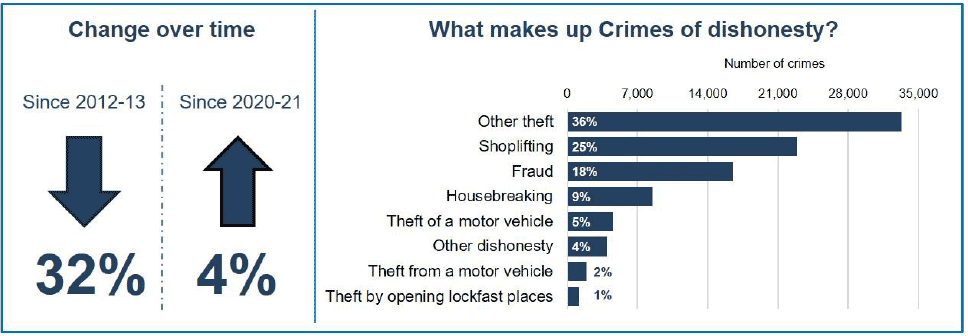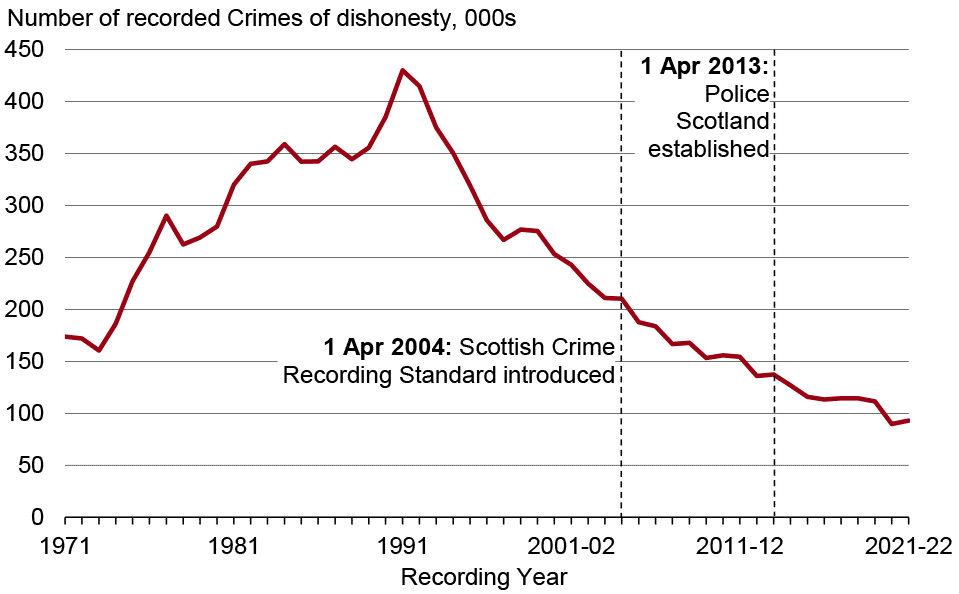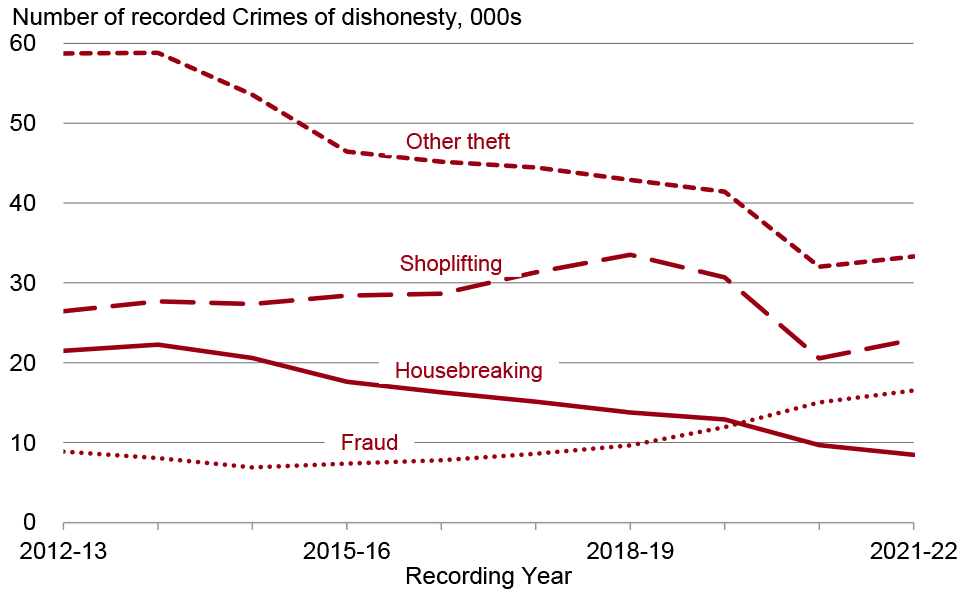Recorded Crime in Scotland, 2021-2022
Statistics on crimes and offences recorded and cleared up by the police in Scotland in 2021-22, split by crime or offence group and by local authority.
Crimes of Dishonesty

The Crimes of dishonesty group has not been impacted by the new crime grouping structure, used for the first time in this year’s bulletin.
Crimes of dishonesty is the largest crime group, accounting for just under a third (32%) of all crime recorded in Scotland in 2021-22. Between 2020-21 and 2021-22, the number of Crimes of dishonesty recorded by the police in Scotland increased by 4%, from 89,731 to 92,873.
Chart 9 below shows the number of Crimes of dishonesty from 1971 onwards. Crimes of dishonesty increased for a long period since 1971 and peaked in 1991. After then, there has been a long-term decreasing trend, with a decrease of 78% between 1991 and 2021-22.

The national rate of recorded Crimes of dishonesty was 170 per 10,000 population in 2021-22, an increase from 164 per 10,000 population in 2020-21.
In 2021-22, of all Crimes of dishonesty:
- Other theft accounted for 36%. This has consistently been the biggest category
- Shoplifting accounted for 25%
- Fraud accounted for 18%
- Housebreaking accounted for 9%
- Theft of and from a motor vehicle together accounted for 7%
- Other dishonesty accounted for 4%
- Theft by opening lockfast places accounted for 1%
All these categories except Fraud have seen large decreases in the number of crimes recorded over the past ten years. Fraud has seen an increase, up 86% since 2012-13.
Chart 10 shows the four largest categories within Crimes of dishonesty over the last ten years, and gives an indication of the trend and scale of each category.

The following sections discuss in more detail trends for each crime category comprised in the Crimes of dishonesty crime group. These are:
- Crimes of dishonesty
- Housebreaking
- Theft by opening lockfast places
- Theft from a Motor Vehicle
- Theft of motor vehicle
- Shoplifting
- Other theft
- Fraud
- Other dishonesty
Housebreaking
Housebreaking accounted for 9% of Crimes of dishonesty. Over the ten year period from 2012-13 to 2021-22 this crime group has decreased by 61%, including a 13% decrease from 9,706 in 2020-21 to 8,489 in 2021-22.
Theft by opening lockfast places
Theft by opening a lockfast place accounted for 1% of Crimes of dishonesty. Over the ten year period from 2012-13 to 2021-22, this crime has seen a decrease of 63%. The number of crimes recorded in this category has remained broadly stable in the most recent year, with 1,207 in 2020-21 and 1,203 in 2021-22.
Theft from a Motor Vehicle
Theft from a motor vehicle accounted for 2% of Crimes of dishonesty. Over the ten year period from 2012-13 to 2021-22 this crime has seen a large decrease of 69%, including an 8% decrease from 2,108 crimes in 2020-21 to 1,936 in 2021-22.
Theft of motor vehicle
Theft of a motor vehicle accounted for 5% of Crimes of dishonesty. Over the ten year period from 2012-13 to 2021-22 this crime has seen a decrease of 21%. There was a 5% increase in the most recent year, from 4,311 crimes in 2020-21 to 4,512 in 2021-22.
Shoplifting
Shoplifting accounted for a quarter (25%) of Crimes of dishonesty. There was an increasing trend since 2014-15, which was interrupted by a decrease in 2019-20 and a further larger decrease in 2020-21. This was likely to be due to the Covid-19 pandemic related restrictions. There was an 11% increase in the most recent year, from 20,557 crimes in 2020-21 to 22,913 in 2021-22. This remains 32% lower than the high in 2018-19. Over the ten year period from 2012-13 to 2021-22 this crime has seen a decrease of 13%.
Other theft
Other theft consists of Theft of pedal cycles, Theft from a motor vehicle not elsewhere classified and Theft not elsewhere classified (excl. motor vehicles).
This category is the largest in Crimes of dishonesty, accounting for 36% of these crimes. Over the ten year period from 2012-13 to 2021-22, Other theft has seen a decrease of 43%. There was a 4% increase in the most recent year, from 32,017 crimes in 2020-21 to 33,305 in 2021-22.
Fraud
Crimes of Fraud accounted for 18% of Crimes of dishonesty. Fraud has seen an upward trend since 2014-15, increasing by 86% since 2012-13. There was a 10% increase in the most recent year, from 15,031 crimes in 2020-21 to 16,536 in 2021-22.
Much of the recent increase in Fraud has related to cyber-crimes which we estimate to now account for almost half of all Frauds (48%) and saw a dramatic rise during 2020-21. However, the increase in 2021-22 was due to a rise in non-cyber Fraud, which returned to pre-pandemic levels, whilst the estimated levels of cyber-related Fraud remained similar to 2020-21. Further information on this change is available in the Cyber-crime chapter.
Other dishonesty
Other dishonesty includes crimes of Reset, Corruption, Embezzlement and other crimes of forgery which are not classified elsewhere.
Other dishonesty accounted for 4% of Crimes of dishonesty. Over the ten year period from 2012-13 to 2021-22 this crime has seen a decrease of 24%, including a 17% decrease in the most recent year, from 4,794 crimes in 2020-21 to 3,979 in 2021-22.
Contact
Email: Justice_Analysts@gov.scot
There is a problem
Thanks for your feedback